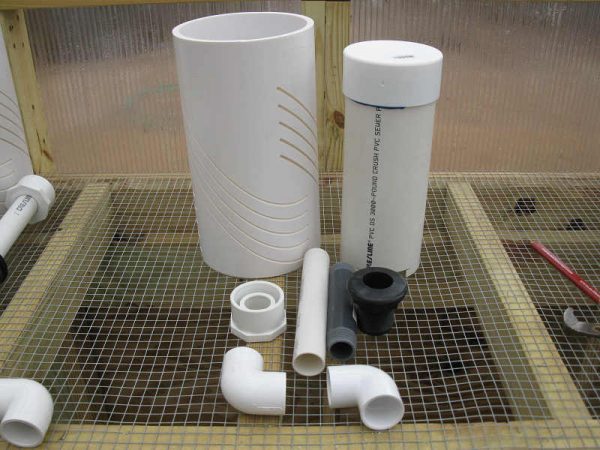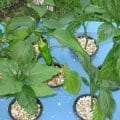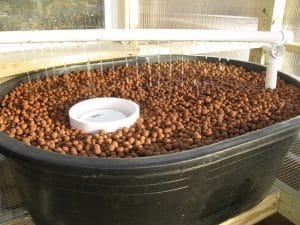A bell siphon is a critical component of an ebb and flow aquaponics system. In an ebb and flow system, the hydroponic plant beds are filled with water, completely covering the plant’s roots and then drained of all the water, leaving the roots temporarily exposed and able to take in oxygen. These systems, also known as flood and drain systems, need a method for removing water from the hydroponic beds and this style of siphon fits that need perfectly. The bell siphon is used for the drainage portion of the systems, and it helps to move water easily and efficiently from the plant bed into the lower tank where the fish grow. Here we explain how the siphon works and its use in an Aquaponic System.
How a Bell Siphon Works
The inner workings of a bell siphon may seem a bit complicated. The siphon is made of several pieces. The bell is the visible piece you can see as the exterior of the device, or it could be covered by a media guard. Inside of it, you will find the accelerator, the standpipe, the water break, and in some cases a media filter to further prevent material from the grow bed from flowing into the lower tank. The standpipe is the main pipe that connects the aquaponic grow beds to the fish tank below. Its height is the determining factor in how high the water level will get during the flood phase. The size of the bell determines how much water is moved through the system with each cycle. This can also affect how quickly the aquaponic grow beds drain.
The entire process works on the principals of hydro-static pressure, air pressure changes, and a little bit of gravity. To uncomplicated things, think of the siphon as working based on suction. If you have ever seen someone siphon gas on television or in the movies, then you have a basic idea of how a bell siphon works. The suction removes the air from the tubing and pulls the liquid in behind it, causing the fluid to flow. The same principal is what makes a bell siphon work only in this case it’s the water level that starts the flow. Once the water gets high enough to completely fill the bell and remove all the air, the pressure changes, allowing the water to begin to drain through the standpipe into the tank below. This process continues until all the water is drained out and the siphon pulls in air instead. That last gasp of air changes the pressure within the system again, allowing the filling process to start back over.
Bell Siphon for Aquaponics
Using a bell siphon for aquaponics has become a very popular option, especially with ebb and flow setups
One of the biggest benefits of using a bell siphon for aquaponics is that the process works automatically. This is really the major selling point for this style of siphon. Unlike other methods used in ebb and flow aquaponic systems, the bell style of siphon controls the flood and drain cycle for you. No need for a timer, no need for manual draining, no need for additional drainage equipment. Once the siphon is properly installed and adjusted for your unique situation, just add water, and it takes care of the rest. As water fills the grow bed and the bell the process begins. Once full, the siphon starts draining right away, and after the draining has finished water can start to fill up again. This prevents extra work on your part while ensuring that your aquaponic system functions at maximum efficiency. It is really the perfect solution once you get tweaked to work properly.
Getting everything working just the way you want it takes a little bit of work initially. Some tips for proper setup and troubleshooting include:
- Ensure the standpipe is level – Too much tilt will cause the system to drain too quickly or too slowly.
- Consider your placement – Before you drill that hole to install your siphon and piping, consider where you want to put it. The preferred placement is either in the center or even farther from the point water enters the bed.
- Weigh down your bell – Rising water levels or debris in the bottom of the grow bed can cause the bell to rise too high over the standpipe. Weighing down the bell will prevent this from interfering with the siphon’s normal function.
- Check routinely for blockage – Grow bed media, sludge build-up, and even foreign objects can clog or block any part of the siphon or piping. Check the whole system on a regular basis, so you can catch these issues before they shut your system down.
- Watch root growth – If your roots get too long and are drawn into the media guard, bell, or media filter they can also cause a clog situation. Keep an eye on roots and redirect them if this seems to be an issue.
Using a bell siphon in your ebb and flow system is an excellent way to ensure its success. It works automatically, benefits the plants and fish, and keeps the water moving through the system efficiently. Although the process may seem complicated, with some basic tips and a little routine cleaning and troubleshooting, this style of siphon can be very successful in your aquaponic system.















Leave A Comment